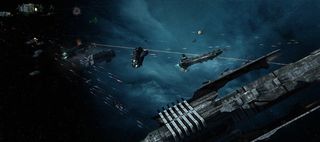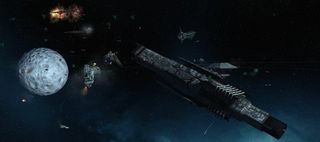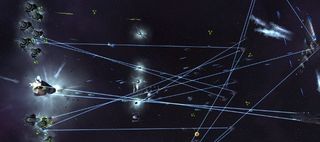
Sins of a Solar Empire: Rebellion's new Titan-class capital ships can single-handedly tilt the balance of war. I learned this when attacking an enemy's forward base with a near invincible trio of veteran capital ships and a powerful attendant fleet of cruisers and frigates. My Kol Battleship, Sova Carrier, and Dunov Battlecruiser were sweeping the TEC Rebels toward their defenses when the enormous dark shape of the new Ragnarov Titan appeared beside its foundry. Foolishly, I directed my fleet to engage it.
The Ragnarov is the purest expression of both the TEC Rebel faction's philosophy and the dichotomies that drive the new Rebellion stand-alone expansion. It is a giant spacefaring shotgun whose sole purpose is focused aggression. Its elongated hull serves to mount a massive railgun capable of smashing apart capital ships with the deadly Snipe ability, or it can thin out a more numerous fleet with its Scattershot ability, which not only damages targets in a cone in front of the Ragnarov, but also lowers their armor. To go toe-to-toe with the Ragnarov, as I tried to do, is to court death.
With a rebel yell
It is the perfect weapon for the TEC Rebel faction, who have split with the TEC Loyalist faction due to the latter's belief that the TEC should pursue armed and fortified isolationism and the Rebels' conviction that the TEC will have peace after its enemies are dead. While both factions belong to the same race and share about 85% of the same technologies and units, that last 15% bends them toward very different strategies and play styles. The rebels thrive on aggressive warfare, while the loyalists are natural turtlers.

The other races have suffered their own schisms in Rebellion, with a similar impact on how they play. Each race now has a loyalist and rebel faction that largely follows a hawks-doves split, although in the case of the brutal Vasari, it's more like hawks and slightly-more-xenophobic-and-fascist hawks. You can play to your factions' natural philosophical inclinations, which is an easier, more limiting road, or you can attempt to find a more balanced approach through research priorities and diplomacy.
Developer Ironclad Games frames Rebellion as a natural follow-up to the Diplomacy expansion that completed Sins' transformation from a traditional RTS into a fully-fledged 4X game. Where Diplomacy made conciliation and alliance-making a viable alternative to conquest (conquest that was itself more difficult due to the defensive emphasis of the Entrenchment expansion), Rebellion rebalances the game to promote both more conflict and more viable play styles for each faction. It also marks a turn in the game's fiction toward Warhammer-esque grimdarkness. The three original races have cracked under the strain of endless war and are now at war with themselves as they lose hope of achieving either victory or peace. Now, armed with a new capital ship for each race, a Titan for each faction, and new corvette-class support ships (that have a depressing tendency to die like flies), they are ready to shatter the defenses that Entrenchment brought into play, and put Diplomacy under fire.
The vastness of space
With every Sins expansion I half-expect that the game will finally jump the shark, and each time I am pleasantly surprised to find that Ironclad seems to have an endless bag of tricks for refreshing the four year-old RTS without breaking it. But I do wonder how much bigger Sins of a Solar Empire can get. The research tree is enormous and faction-specific, with each race having its own names for the same basic improvements. Diplomacy still feels a bit disconnected from the main action of the game and, while you can now keep track of victory conditions in a helpful sidebar, the nature of the diplomatic victory is that nobody seems to be making much progress until suddenly one player is making tons of progress. It's a difficult thing to account for when you're trying to assess threats and formulate strategies. Now each faction has its own spin on the original three races, and it's not always immediately apparent how those differences translate to action.

I love that Ironclad has resisted the temptation to include a single-player campaign, typically the worst thing about RTS games, but that also means it lacks a mode which explains the fiction behind each faction and their strengths and weaknesses. It's all well and good to talk about the Vasari's burning hatred for the TEC, and the Advent Rebels' conviction that they must purify their race, but that doesn't help me understand Rebellion's trade-offs, or what some of the new upgrades and abilities are actually supposed to do. Having a little more flavor can take some of the workload off tooltips and statistics, and require a bit less trial-and-error from the player.
The biggest gaming news, reviews and hardware deals
Keep up to date with the most important stories and the best deals, as picked by the PC Gamer team.
That learning-curve issue, however, is mitigated by Sins: Rebellion's ability to convince you to stick around long enough to figure everything out. Grandeur and splendor are addictive in their own right.
Clash of the Titans
Back to my encounter with the Ragnarov. With two high-level capital ships lost in action before my fleet could retreat, I realized the only thing that could stop that monster would be a Titan of my own. So while the AI lumbered into a counterattack, I researched and built the Ankylon, which is the TEC Loyalists' defensive-oriented answer to the Ragnarov.
The Ankylon rushed to the aid of my surviving fleet as it huddled around a beleaguered starbase in orbit around one of my main planets. Starbases, which used to give defenders an almost unbreakable advantage, meet their match in the Titans. But when my Ankylon joined the fight, the rebels' Ragnarov-led fleet met its match as well, and Rebellion showed-off its upgraded fireworks.

The lighting on these ships is just incredible. They glimmer in the dark of space, and then blaze with laser beams, a wash of explosions, and the fire of distant stars. The Titans move with a ponderous menace: my Ankylon pulled into range of the Ragnarov and the slowly rotated to bring its massive, slab-like sides to bear for a crushing broadside. I could make out the main guns firing massive plasma projectiles down at the Ragnarov, while pulse weapons reached out like tendrils for nearby fighters and bombers. The Ragnarov slewed around to fight back, the lights of incoming weapons playing over its mottled sheet-metal hull.
Even as it brought its guns to bear, the fight was turning against the rebels. Boosted by the Ankylon's Group Shield ability, which gives friendly ships in the area a big defensive boost, my fleet was steadily whittling down the Ragnarov's backup, and the Ragnarov itself didn't quite have the firepower to take out the Ankylon. It fell back alongside its surviving fleet, while my own forces regrouped and started getting ready for the next round of the struggle. In Sins of a Solar Empire, the struggle always continues.
Most Popular




